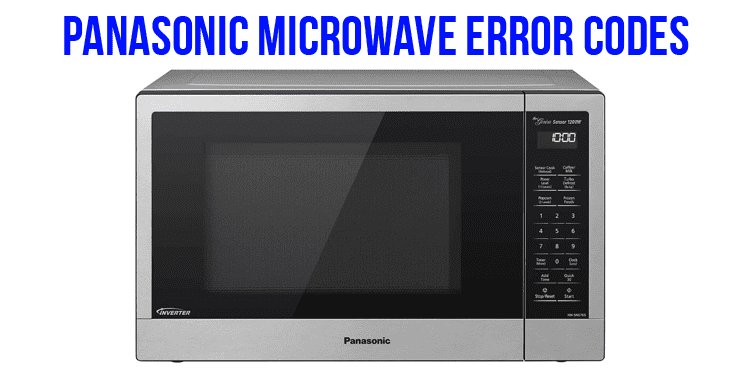
Here’s the deal: error codes like “LE” are your microwave’s way of communicating that something is amiss. Just like you wouldn’t ignore strange sounds coming from your car’s engine, it’s best not to brush off what your microwave is trying to tell you. Understanding what this code means and what action to take will not only help prolong the life of your microwave but also ensure that it’s running safely. So let’s dive into what this error code means, why it appears, and what steps you can take to fix it.
What Does the Panasonic “LE” Error Code Mean?
When you see the “LE” error code on your Panasonic microwave, it typically stands for “Latch Error.” This means there’s an issue with the door latch mechanism. Imagine trying to drive a car with a door that doesn’t close properly—it’s not only inconvenient but also potentially dangerous. Similarly, if your microwave door stays unlatched, it can be a problem. A microwave needs its door to be firmly closed to operate safely and efficiently. When the latch isn’t engaging correctly, the microwave senses something’s off and refuses to run.
This error can occur due to a variety of reasons. One common cause is food particles or debris caught in the latch. Just like a small pebble in your shoe can halt your stride, even the tiniest object can stop the latch from working properly. Another potential cause is wear and tear over time—it happens to the best of us, right? The mechanical parts that keep the door snug can become worn out, leading to miscommunication between the door and the machine.
Before you rush to the store or start panicking, the good news is that many latch issues can be fixed easily at home. By giving your microwave a thorough clean or making minor adjustments, you can often resolve the problem without the need for professional help. However, if cleaning doesn’t solve it, there could be a larger issue at play, and that’s when you might need a bit more than a DIY approach.
How to Fix the LE Error Code at Home
So, you’ve decided you can’t just ignore this pesky “LE” error code. Good choice! Let’s tackle it step by step. First and foremost, ensure the microwave is unplugged before you begin. Safety first—think of it as putting on your seatbelt before driving. Next, take a close look at the door and its latch. Are there any visible crumbs or debris? A simple wipe with a damp cloth can often dislodge anything that’s causing the problem.
If cleaning it out doesn’t do the trick, it might be time to check the alignment of the door. Sometimes, the door can become misaligned through regular use, like when a picture frame goes slightly crooked on your wall. Gently push or tap the door to see if it aligns better. You might feel a click when it seats properly, indicating that the latch is now in place.
In cases where neither cleaning nor gentle adjustments solve the issue, you may need to inspect the latch itself. If the latch looks broken or overly loose, you might need a replacement. This is similar to replacing a worn-out button on a favorite coat—it’s a small repair that can make a world of difference. If you’re unsure about tackling this yourself, a quick call to a professional or a visit to an appliance repair shop could save you the hassle.
Preventative Measures to Avoid Future Errors
Now that you’ve tackled the problem, it’s time to think about the future. How can we prevent this “LE” error from rearing its ugly head again? Regular maintenance and cleanliness go a long way. Isn’t it true that a stitch in time saves nine? Keeping the microwave interior and door area clean will help prevent debris from interfering with the latch mechanism.
Additionally, be mindful when opening and closing the door. Gentle handling ensures the door and latch don’t wear out as quickly. Think of it like carefully closing the door to your car instead of slamming it shut. By treating your microwave with care, you extend its life and reduce the chances of encountering error codes.
Lastly, consider scheduling periodic check-ups if your microwave sees heavy use. Much like servicing your car, a little preventive maintenance can help catch minor issues before they become major headaches. It can also provide peace of mind, knowing your microwave is in good working order.
When to Seek Professional Help
Even with the best care, sometimes these home fixes might not be enough. You might be wondering, “When should I call in reinforcements?” If after cleaning and adjusting, the “LE” error persists, it might be time to reach out to a professional. This is akin to seeing a mechanic when your car starts making that mysterious noise again.
An expert can diagnose issues that are hard to see with the naked eye. They’ll have specialized tools and knowledge to address underlying problems—whether it’s a faulty sensor or electrical malfunction. Investing in a professional repair can end up saving you money in the long run by preventing further damage.
Remember, ignoring the “LE” error code is like ignoring that persistent rain leak in your roof—it won’t just go away on its own. Addressing it proactively is key to keeping your microwave running smoothly and ensuring your kitchen remains a safe place for meal prep. In the end, knowing when to DIY and when to call in expert help will empower you to make the best decisions for your appliances and your home.